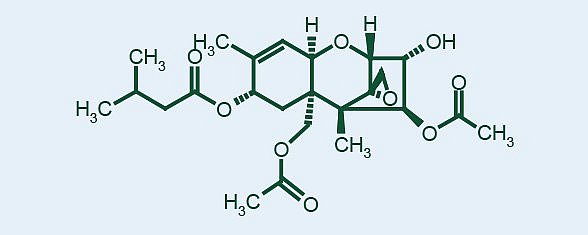What is T-2/HT-2?

This mycotoxin is a member of the fungal metabolites known as the trichothecenes. The trichothecenes are divided into two groups: macrocyclic and non-macrocyclic. T-2 toxin is in the non-macrocyclic group; this group is also subdivided into the Type-A and Type-B trichothecences. The Type-A trichothecenes include T-2 toxin, HT-2 toxin and diacetoxyscirpenol (DAS) as mycotoxin components.
Production and occurrence
Fusarium sporotrichioides is the principle fungus responsible for the production of T-2 toxin. Some strains of this fungus also produce DAS and HT-2 toxin, however DAS is the least common of the three toxins. Corn, wheat, barley, oats, rice, rye and other crops have been reported to contain the T-2 toxin. Natural occurrence has been reported in Asia, Africa, South America, Europe and North America. Natural levels range from near zero to 10 ppm with a few exceptions showing levels of 15-40 ppm. The toxin production is greatest with increased humidity and temperatures of 6-24°C. Storage of commodities below 14% moisture will minimize further fungal growth and production of the T-2 toxin. In addition grains kept free of insect damage and dried prior to storage may decrease the effects of further contamination.
Poultry feed and certain other food products are most commonly contaminated. In the United States T-2 toxin is infrequently found and, if found, likely results from inadequate storage of products.
The Fusarium mold on corn primarily appears white, in some instances the mold can also appear pink to reddish, often beginning at the tip of the ear. Occasional blue-black specks will be found on the husk and ear shank to indicate mold contamination.
Toxicity
The major attribute of the T-2 toxin and other trichothecenes is that they inhibit protein synthesis which is followed by a secondary disruption of DNA and RNA synthesis (Ueno, 1984). It affects the actively dividing cells such as those lining the gastrointestinal tract, skin, lymphoid and erythroid cells. It can decrease antibody levels, immunoglobulins and certain other humoral factors. The effects include weight loss or poor weight gain, bloody diarrhea, dermal necrosis or beak lesions, hemorrhage and decreased production (weight gain, eggs, milk, etc.). The Type-A trichothecenes are more toxic to poultry species than the Type-B trichothecenes. Yellow caseous plaques, occurring at the margin of the beak, mucosa of the hard palate, angle of the mouth and tongue, characterize typical oral lesions. Severity of the lesions will increase with prolonged feeding and increased dietary levels. Beak or oral lesions can occur at dietary levels of 4 mg/kg after 1 week, 0.4 mg/kg after 7 weeks, and with 1-4 mg/kg, beak or oral lesions occurred in addition to decreased weight and feed intake after 3 weeks (Richard, 2007). There is also a synergism between aflatoxin and T-2 toxin discussed (Huff et al., 1988).
Published on:
Mycotoxin